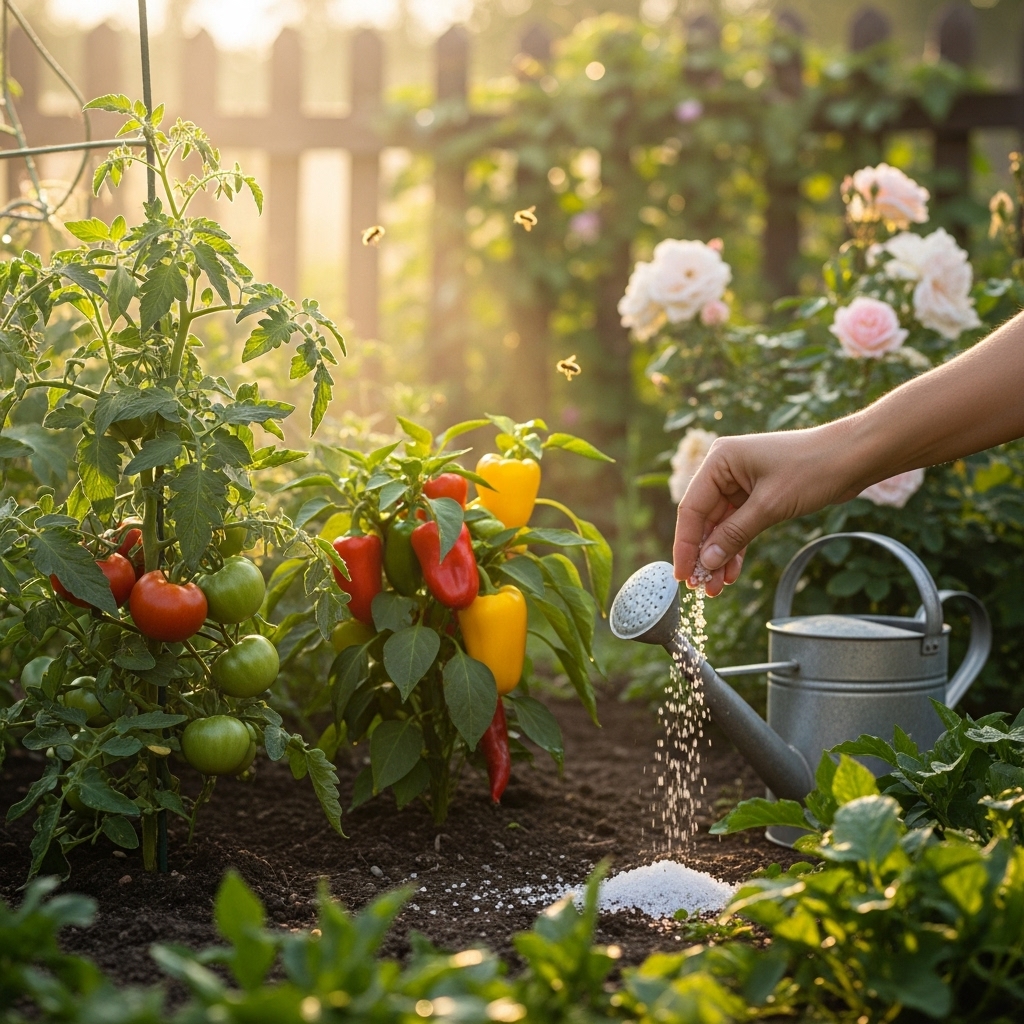As an avid gardener, I’ve discovered that Epsom salt can be a game-changer for nurturing my beloved tomatoes, peppers, and roses. Its benefits are impressive, providing essential nutrients that enhance growth, flavor, and blooms.
The Role of Epsom Salt in Plant Health

When I first stumbled upon Epsom salt, I was skeptical about its benefits for my garden. After doing some research and experimenting, I quickly realized that this simple compound, composed of magnesium sulfate, has incredible potential for various plants, particularly tomatoes, peppers, and roses. The magnesium in Epsom salt plays several vital roles in plant health, and its sulfur content is equally important. Let me share how these benefits manifest in the growth of these three beloved plants.
Enhancing Nutrient Uptake
One of the primary benefits I’ve noticed with Epsom salt is its ability to enhance nutrient uptake. Magnesium, an essential macronutrient, helps plants absorb other nutrients more effectively. For tomatoes and peppers, which require ample amounts of nutrients to thrive, this means they can better utilize nitrogen, phosphorus, and potassium. I’ve noticed that my plants displaying nutrient deficiencies often recover quickly with Epsom salt applications. The result is healthier foliage and sturdier stems.
Improving Flavor and Yield
Flavor is everything when it comes to growing delicious tomatoes and peppers. With Epsom salt, I found that my plants produced fruits that are not just visually appealing but also bursting with flavor. Magnesium contributes to the formation of chlorophyll, which aids in photosynthesis. The more efficient photosynthesis is, the more energy the plant has to create sugars, leading to tastier fruits. I’ve experienced this firsthand, as my tomatoes taste sweeter and my peppers have a delightful crunch. The increased yield is a bonus that I’m always excited about, as it allows me to share my harvest with family and friends.
Encouraging Blooming in Roses
For rose enthusiasts like me, achieving vibrant blooms is often a top priority. Epsom salt can significantly enhance blooming in roses. The magnesium aids in the formation of new buds and blooms, making my roses more prolific. After a good dose of Epsom salt, I’ve noticed my roses not only bloom more frequently but also exhibit richer colors and healthier leaves. The sulfur in Epsom salt also supports the overall health of the plant, contributing to stronger stems and foliage.
Preventing Blossom-End Rot
One of the most distressing problems I faced while growing tomatoes was blossom-end rot, a condition caused by calcium deficiency. Interestingly, I learned that magnesium plays a pivotal role in calcium absorption. By applying Epsom salt to my tomato plants, I found that I could help prevent this issue. The healthier and more balanced my plants are, the less likely I am to encounter blossom-end rot. It’s been a relief to harvest beautiful, unblemished tomatoes after implementing this solution.
How to Use Epsom Salt Effectively
Now that I’ve shared the benefits, you might be wondering how to effectively use Epsom salt in your garden. I typically mix about one tablespoon of Epsom salt in a gallon of water and apply it as a foliar spray or directly to the soil. This method allows for quick absorption, giving my plants an instant boost. I’ve found it especially effective during the growing season, particularly when my plants are flowering or setting fruit. However, moderation is key; I avoid over-applying to prevent any adverse effects.
Timing is Everything
In my gardening experience, timing when to apply Epsom salt can greatly influence its effectiveness. I usually start with my tomatoes and peppers as they begin to flower, and for roses, just as the first buds appear. Regular applications throughout the growing season help maintain the nutrient balance in the soil. I tend to reapply every four to six weeks, ensuring my plants remain happy and healthy. This routine has transformed my garden into a vibrant ecosystem filled with flourishing plants.
Combining with Other Fertilizers
While Epsom salt is beneficial on its own, I’ve found that combining it with other organic fertilizers amplifies the results. Mixing Epsom salt with compost or organic fertilizers like fish emulsion can create a nutrient-rich environment for my plants. This holistic approach has helped me achieve a thriving garden that not only looks good but also produces abundant and flavorful fruits and flowers.
In summary, incorporating Epsom salt into my gardening routine has yielded remarkable benefits for my tomatoes, peppers, and roses. The science behind magnesium and sulfur illustrates why this simple compound is a powerful ally for any gardener. As I continue to explore the many ways Epsom salt can enhance my gardening experience, I’m excited to see what other surprises await in my garden. Stay tuned for more insights as I delve deeper into the specific applications and techniques that have worked wonders for me!
Exploring Other Uses of Epsom Salt in the Garden

Beyond the stellar benefits I’ve experienced with tomatoes, peppers, and roses, I’ve discovered that Epsom salt has a myriad of other applications in the garden. It’s truly remarkable how this one compound can serve multiple purposes, enhancing not just individual plants but also the overall health of my garden ecosystem. Let me share some of the unexpected ways I’ve incorporated Epsom salt into my gardening routine.
Boosting Seed Germination
One of the more surprising benefits of Epsom salt is its ability to improve seed germination. When I started my vegetable seeds indoors, I decided to experiment by soaking them in a solution of Epsom salt and water before planting. The results were astounding! The seeds sprouted faster and had stronger initial growth compared to those that weren’t treated. I usually mix about a teaspoon of Epsom salt into a quart of water and soak my seeds for a few hours. This simple step has turned my seed-starting process into a much more productive endeavor.
Enhancing Soil Quality
I’ve also learned that Epsom salt can be beneficial for soil health. Adding it to my compost pile has enriched the overall quality of the compost, as the magnesium and sulfur release gradually while the compost breaks down. This mixture enriches the nutrients available to my plants as they draw from the composted material. By incorporating Epsom salt into my composting routine, I feel like I’m giving my plants an extra edge in their nutrient quest.
Combatting Pests
While it may not be a primary pest deterrent, I’ve found that Epsom salt can help deter certain pests in my garden. A diluted solution of Epsom salt and water sprayed on plants can create an environment that some pests find unappealing. I’ve particularly noticed a reduction in aphid populations on my plants after applying this mixture. Although I don’t rely solely on Epsom salt for pest control, it can certainly be part of a broader integrated pest management strategy.
Strengthening Plants Against Disease
Another unexpected benefit I’ve observed is that Epsom salt can help strengthen plants against certain diseases. Magnesium is essential for photosynthesis, which in turn boosts the plant’s energy levels and overall health. A stronger plant is often more resilient to diseases and environmental stresses. I make it a practice to apply Epsom salt to my struggling plants, and I often see them bounce back, showing renewed vigor and better defenses against pathogens.
Supporting Other Garden Favorites
My exploration of Epsom salt’s benefits extends to other garden favorites as well. For instance, I’ve experimented with using it on my squash and cucumbers. These plants, like tomatoes and peppers, can benefit from the additional magnesium for fruit production and growth. I’ve noticed that my cucumbers grow more robustly and produce a higher yield when treated with Epsom salt at the right stages of growth. This added versatility makes Epsom salt an invaluable tool in my gardening arsenal.
Creating a Balanced Fertilizer Regimen
In my quest for lush and productive plants, I’ve realized that Epsom salt should be part of a balanced fertilizer regimen. While it’s fantastic for magnesium and sulfur, it shouldn’t replace other essential nutrients. I now keep an eye on the nutritional needs of my garden and assess soil tests to make sure I’m providing a well-rounded approach. Combining Epsom salt with various organic fertilizers allows me to create a tailored nutrient blend that meets the specific needs of each plant type.
Watering with Epsom Salt
Another interesting technique I’ve adopted is watering my plants with Epsom salt. During particularly hot spells, I mix a tablespoon of Epsom salt into my regular watering can. This not only hydrates my plants but also gives them a nutrient boost at the same time. I’ve found that this method is especially effective when my plants are under stress from heat, as it provides both hydration and nutrients essential for recovery and growth.
Maintaining Indoor Plants
My love for gardening extends indoors as well, and Epsom salt has proven beneficial for my houseplants too. A little sprinkle of Epsom salt in the soil of my indoor plants helps enhance their vigor and blooming potential. I tend to apply it sparingly, about once every couple of months, and I’ve noticed that my indoor plants respond positively to this treatment, showing more vibrant foliage and blooms.
With all these diverse uses, Epsom salt has undoubtedly become a staple in my gardening toolkit. Its versatility and effectiveness have allowed me to explore new methods and achieve a thriving garden that continues to surprise me. I’m excited to keep experimenting and sharing my experiences with this remarkable compound!
Exploring the Environmental Impact of Epsom Salt

As I delve deeper into my gardening journey, I can’t help but consider the environmental implications of the products I use, including Epsom salt. While it has proven to be an invaluable asset for my plants, I’ve also taken time to reflect on how it impacts the broader ecosystem. Understanding this aspect has allowed me to make more informed decisions and practice sustainable gardening.
Natural and Biodegradable
One of the most significant advantages of Epsom salt is that it’s a natural mineral compound. Unlike many synthetic fertilizers that can release harmful chemicals into the soil and waterways, Epsom salt is biodegradable and does not pose the same risk to the environment. This fact gives me peace of mind when I apply it to my garden, knowing that I’m nurturing my plants without causing long-term harm to the ecosystem. I feel good about using a product that aligns with my values of sustainability and environmental stewardship.
Improving Soil Structure
In my quest to achieve a healthy garden, I’ve found that Epsom salt can contribute positively to soil structure. The magnesium in Epsom salt helps promote better soil aggregation, which is essential for healthy root growth and overall plant health. Over time, this improvement in soil structure can increase water retention and aeration, creating a thriving habitat for beneficial microorganisms. By enhancing the soil, I also foster a more balanced ecosystem that supports not only my plants but also the insects and other wildlife that call my garden home.
Reducing Chemical Dependency
By incorporating Epsom salt into my gardening practices, I’ve been able to reduce my dependency on chemical fertilizers. This transition has not only benefited my plants but has also lessened the potential runoff that could pollute nearby water sources. I’ve noticed that my plants respond well to natural amendments, which encourages me to continue seeking out organic solutions. It’s rewarding to see that opting for Epsom salt not only supports plant health but also contributes to a healthier environment.
Aiding in Soil Remediation
Interestingly, I’ve also discovered that Epsom salt can assist in soil remediation efforts. If I’ve had issues with soil salinity or nutrient depletion, adding Epsom salt can help to correct these problems. The magnesium sulfate helps displace excess sodium in the soil, allowing for better nutrient absorption for my plants. Implementing Epsom salt in this way has enabled me to revive struggling areas of my garden, transforming them into vibrant patches again. This process not only restores productivity but also supports a diverse array of soil life.
Fostering Biodiversity
Being an avid gardener, I recognize the importance of biodiversity in my garden. Epsom salt’s natural properties can help create an environment that is conducive to a variety of plants, insects, and other organisms. By enriching the soil and improving the health of my plants, I’ve attracted beneficial insects like ladybugs and bees, which play a crucial role in pollination. It’s fulfilling to see how a small addition like Epsom salt can create a ripple effect, promoting a thriving ecosystem that supports a myriad of life forms.
Educating Others
As I continue to explore the environmental benefits of Epsom salt, I feel a responsibility to share my experiences with fellow gardeners. I’ve often organized workshops and informal gatherings with friends and neighbors to discuss sustainable gardening practices. Sharing my knowledge about Epsom salt and its benefits empowers others to adopt similar eco-friendly approaches in their gardens. It’s uplifting to witness the community growing more conscious of their gardening choices, and together, we can all make a difference in promoting healthier, more sustainable practices.
Encouraging Organic Gardening
Through my advocacy for Epsom salt, I’ve also been inspired to delve deeper into organic gardening principles. This compound aligns perfectly with my desire to grow food without the use of synthetic pesticides and fertilizers. As I explore more organic methods, I have discovered companion planting, crop rotation, and other techniques that work harmoniously with Epsom salt applications. Each new practice I adopt reinforces my commitment to a holistic approach to gardening, ensuring that I’m fostering a balanced and resilient ecosystem.
Staying Informed and Engaged
As I continue my gardening journey, I’m committed to staying informed about the latest research and practices related to Epsom salt and its environmental impact. Engaging with local gardening clubs and online forums keeps my knowledge fresh and allows me to share insights with others. I’ve found that collaboration and sharing experiences with fellow gardeners create a strong sense of community and encourages sustainable practices that benefit everyone.
With so many benefits and considerations surrounding Epsom salt, I feel invigorated by the potential it holds not just for my garden, but also for the environment as a whole. I’m excited to keep experimenting with this versatile compound and to see how I can further integrate it into my gardening practices while contributing positively to the ecosystem. Epsom salt has proven to be more than just a simple gardening amendment; it’s a gateway to exploring and enhancing the world around me!
Final Thoughts
In my journey with Epsom salt, I’ve realized that it’s not just a tool for enhancing plant health; it’s an ally in promoting sustainability and environmental responsibility. The multifaceted benefits I’ve discovered have not only enriched my gardening experience but also deepened my appreciation for the interconnectedness of our ecosystems. As I continue to learn and share, I’m reminded that every small choice counts in nurturing both our gardens and the planet.
